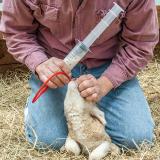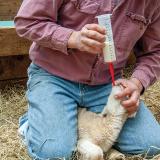Stomach Tubes
Product Details
A safe, easy method for feeding weak lambs and goat kids.
To tube feed a lamb, use with a catheter tip syringe.
Instructions/Diagrams:
Common Uses
Specs
- Red Rubber Tube
- Flexible rubber. 6.0mm. 16" long.
- Clear Plastic Tube
- Easier to insert because they are less flexible than rubber. However, when it’s cold, plastic tubes are stiff and may cause injury during insertion (a greater concern with goat kids). 6.0mm diameter; 16" long.
How to Use
- Be very careful to gently extend the animal's chin so that its neck is straight before carefully inserting the tube. If the light is good you can visually observe the bulge of the tube sliding down the neck. In bad light, we use our fingers to feel its presence. If you can neither feel nor see the tube, it may well be in the animal's hard hollow trachea and thus the lungs. Be cautious of this. If the tube enters the lungs instead of the stomach, pneumonia and starvation could result.
- Pull the tube out gently and restart it. The chance of wrongly inserting the tube is not as great as it may appear. Simply be sure that the tube is inserted in a straight line from the animal's mouth to its stomach.
- Continue to pass the tube into the stomach. The usual distance is 11 or 12 inches. You cannot pass the tube too far, but it is very important to pass the tube far enough. If it is in the correct position you will hear a gurgling sound through the empty syringe.
- Should the solution not run, the cause could be an airlock or possibly with older animals, the teeth could be clamped on the upper part of the tube. If an airlock occurs, slide tube in and out about 1/2 inch.
- Do not ram the milk into the stomach. We usually do not actually insert the plunger unless using thick colostrum which will not flow on its own. If the plunger is used, gently push the milk into the animals stomach.
Shepherd’s Choice® Management Tip
On many farms during lambing time, one tube gets used over and over again without being cleaned or disinfected. Lambs that are being treated for scours or pneumonia should not be tube fed with a common tube. If you tube feed a sick lamb with a tube, wash it, disinfect it and let it dry before using it again. Keep plenty of tubes on hand.Precautions
Clear plastic tubes are a little easier to insert because they’re less flexible. However, when it’s cold (Midwest USA cold), plastic tubes are stiff and may cause injury during insertion (a greater concern with goat kids). Red rubber tubes are the most flexible.
Producers should NOT tube lambs that cannot hold their heads upright. In most cases these are hypothermic lambs. They need glucose (IP) and warming first. Once the animal has been revived and can hold its head up, then you can use the various stomach tube devices to deliver nourishment.
Read all warnings and cautions on label. For livestock use only.
Listed below are recommended optional components or related items. Your particular situation may require alternative recommendations. Please call and talk to our consultants if there are any questions at 800-282-6631.
-
Drenching and Vaccinating
140cc Syringe (4.6 oz) Catheter Tip
Item #553000 -Most commonly used for stomach tubing weak lambs and kids. Can be used as a drencher as well.
$9.00 -
Drenching and Vaccinating
60cc Syringe (2 oz) Catheter Tip
Item #553100 -Most commonly used for stomach tubing weak lambs and kids. Can be used as a drencher as well.
$2.00
Write a Review
You must be logged in to leave a review. Please sign in.
Corrine R from Washington
Bought to have on hand in case we had a weak goat kid who wouldn't suck. Was very happy to have it ready when twins were born premature and needed to tube the doeling kid. Compared to previous use of flexible catheters for orphan kitten, this tube was super easy to use. I really liked the somewhat stiffness of the tube for inserting. I needed a 2nd person to push the syringe to allow milk to flow, so this was a 2 person job.
Ed K from South Dakota
I'd like to give this product a 5 because we have saved countless lambs with these tubes and large syringe. The only complaint is that sometimes they can pop off the syringe. Putting on clean is a must. I prefer the clear one because it is stiff enough to feed it down the lamb without supporting it with the other hand. They have to be put down the lamb slowly and you can't inject the lamb too fast. They buy time and get a lamb going when you have a lot of sheep to take care when lambing is at it's peak. For all the things a person buys to take care of sheep that are lambing, this is one of the most important things to have. I make sure I never find myself without having these on hand.
Christina C from California
Being a novice, I tried both tubes and I prefer the clear tube. It is easier to get into the lamb's stomach and the milk feeds into the stomach easier. The red tube, for me, seems to be easy for the lambs to pinch if they bite or start moving. The clear tube is more rigid but it softens quickly as soon as it warms in the lambs mouth. Also, it is easy to see the milk left in the tube when you are removing the tube, which makes it easier to assure the lamb doesn't aspirate the remaining milk.
Rose M from Texas
I use the soft red tube. It has made the difference between life an death numerous times. Sometimes one tubing to get colostrum into the stomach of a weak lamb is all it needs to get it on its fee and strong enough to nurse on its on. For others, it may take supplementation through the tube for several days to get it strong enough. Just in the last month, I had cases of both. I had one lamb who was big enough but a weak sucker. I tubed her once and it gave her the strength to nurse on her own with vigor. Then I had tiny twins born 3 and 4 pounds. The 3 pounder could not stand. Neither were strong enough to latch on and nurse with enough vigor. We milked the mother and tubed them for several days. Each day they were stronger and able to nurse a bit on their own, so that we only had to tube once a day. By day 5 they were totally independent and full of energy. Tubing is a little scary but with the good instructions available online, it is very doable. It's a life saver and better than a bottle when the lamb needs a quick start.
Janel B from Louisiana
Very easy to use. If you are unfamiliar with tube feeding please refer to a vet for guidance. I have both the red and clear tubes but the clear one is (in my opinion) better. I feel like I can really see that the milk has totally drained from the tube.
















